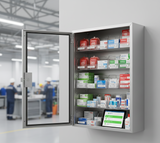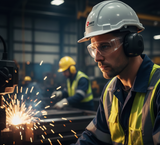Beyond the Label: Your Guide to Chemical Safety in the Workplace
Chemicals are an integral part of many modern workplaces, from cleaning supplies in an office to specialized reagents in a lab, or industrial solvents in a manufacturing plant. While essential, the safe handling and storage of these substances are paramount, not just for compliance but for the well-being of your employees and the longevity of your business.
At Your Safety Company, we understand that chemical safety goes far beyond simply reading a label. It requires a comprehensive approach, robust training, and the right protective equipment. Let’s dive into what every business needs to know to navigate the complexities of chemical safety effectively.
The Foundation: Understanding Your Chemicals
Before you can implement effective safety measures, you need to thoroughly understand the chemicals present in your workplace.
-
Safety Data Sheets (SDS): Your Chemical Encyclopedia
-
Every hazardous chemical in your workplace must have an up-to-date Safety Data Sheet (formerly Material Safety Data Sheet or MSDS). The SDS is a critical document providing comprehensive information about the substance, including:
-
Hazard identification
-
First-aid measures
-
Fire-fighting measures
-
Accidental release measures
-
Handling and storage
-
Exposure controls/personal protection (PPE)
-
Physical and chemical properties
-
Toxicological information
-
-
Action for Businesses: Ensure all SDS are readily accessible to employees who work with or near chemicals, ideally both physically and electronically.
-
-
Proper Labeling:
-
While the SDS provides detail, labels offer immediate, concise information. All chemical containers, whether received from a supplier or transferred to secondary containers, must be properly labeled. These labels should clearly identify the chemical, its hazards, and appropriate precautions.
-
Action for Businesses: Train employees to understand label pictograms, signal words (e.g., "Danger," "Warning"), and hazard statements.
-
Essential Pillars of Chemical Safety
Once you understand your chemicals, you can build a robust safety program.
-
Hazard Assessment & Risk Control:
-
Identify all areas where chemicals are used, stored, or handled. Assess the potential for exposure, spills, or other incidents.
-
Hierarchy of Controls: Apply the hierarchy of controls:
-
Elimination/Substitution: Can you remove the hazardous chemical or replace it with a less hazardous alternative?
-
Engineering Controls: Can you modify the workspace (e.g., ventilation systems, fume hoods, enclosed processes) to reduce exposure?
-
Administrative Controls: Implement safe work procedures, rotation of tasks, and clear signage.
-
Personal Protective Equipment (PPE): This is your last line of defense.
-
-
-
Safe Storage & Handling:
-
Segregation: Store incompatible chemicals separately to prevent dangerous reactions. Refer to SDS for specific guidelines.
-
Ventilation: Ensure storage areas are well-ventilated.
-
Container Integrity: Store chemicals in original, properly labeled containers whenever possible. If transferring, use appropriate secondary containers and label them correctly.
-
Security: Restrict access to hazardous chemicals to authorized personnel.
-
-
Emergency Preparedness:
-
Spill Response: Develop clear procedures for chemical spills, including appropriate PPE, spill kits, and disposal methods.
-
First Aid: Ensure first aid stations are well-stocked for chemical exposures (e.g., burn treatments, eye wash solutions).
-
Eyewash Stations & Safety Showers: These are critical for immediate decontamination after chemical splashes. They must be easily accessible, well-maintained, and regularly tested.
-
Evacuation Plan: Integrate chemical incidents into your overall emergency evacuation plan.
-
The Right Gear: Your PPE for Chemical Protection
Appropriate Personal Protective Equipment (PPE) is indispensable for protecting employees from chemical exposure. Your Safety Company offers a full range of products designed for chemical safety:
-
Chemical-Resistant Gloves: From thin nitrile gloves for splash protection to heavy-duty neoprene or butyl gloves for immersion, choosing the right material and thickness is crucial.
-
Eye & Face Protection: Chemical splash goggles and face shields are essential to protect against splashes and mists.
-
Respiratory Protection: Depending on airborne chemical hazards, respirators (e.g., half-mask, full-face, air-purifying) with the correct cartridges or filters are necessary. Proper fit-testing and training are vital.
-
Protective Clothing: Aprons, suits, or coveralls made from chemical-resistant materials provide skin protection.
-
Spill Kits: Having readily available chemical spill kits with absorbents, neutralizers, and disposal bags can quickly contain and mitigate incidents.
Remember: The type of PPE required will vary significantly based on the specific chemical and the task being performed. Always consult the SDS and conduct a thorough risk assessment.
Investing in Chemical Safety is Investing in Your Future
Neglecting chemical safety can lead to severe consequences: serious employee injuries, costly regulatory fines, environmental damage, and significant damage to your company's reputation.
By establishing a robust chemical safety program – one that emphasizes understanding, proper handling, emergency preparedness, and the right PPE – you protect your most valuable assets: your people and your business.
Your Safety Company is your partner in building a safer workplace. Visit yoursafetycompany.com today to explore our extensive selection of chemical-resistant gloves, eye protection, respiratory solutions, spill kits, and eyewash stations. Let us help you go beyond the label and achieve superior chemical safety.
Recent Posts
-
Beyond the Big Box: Why Yoursafetycompany.com is the Smarter Choice for Your First-Aid Program
When it comes to workplace first aid, ensuring your business is compliant and your employees are pro …1st Jan 2026 -
The 2026 Safety Checklist: Is Your Crew Truly Protected?
As we move into the new year, it’s the perfect time to look past the daily grind and evaluate the ge …23rd Dec 2025 -
Beyond the Buzz: Why Proper Hearing Protection is Non-Negotiable on Your Job Site
On any given workday, the sounds of progress—drills, saws, heavy machinery, and even loud conversati …22nd Dec 2025



